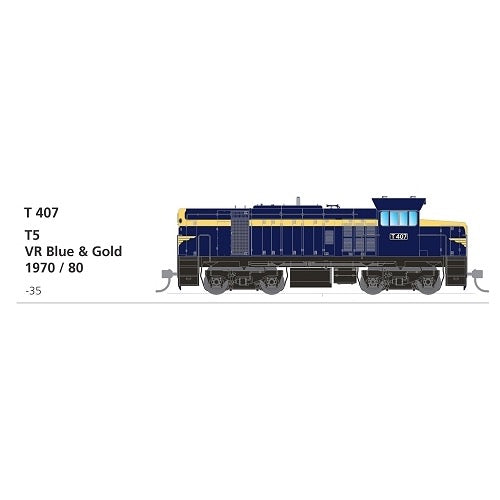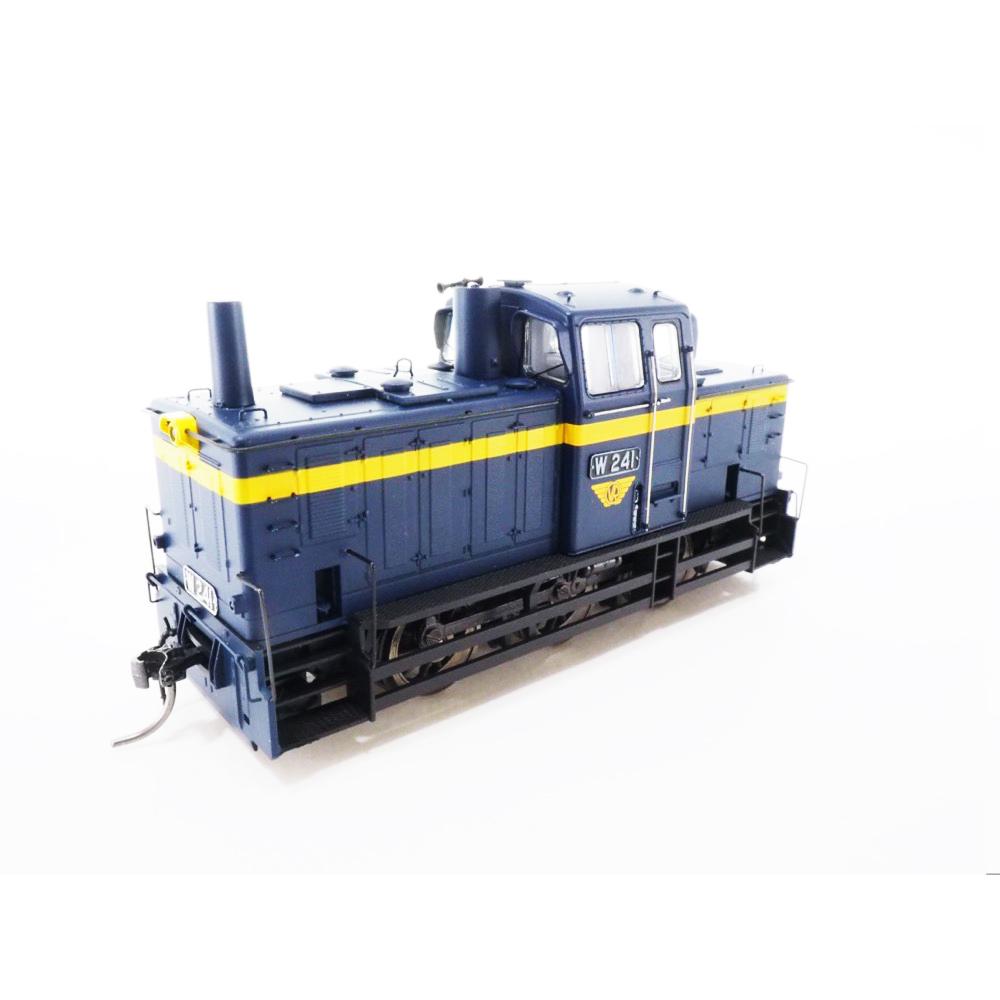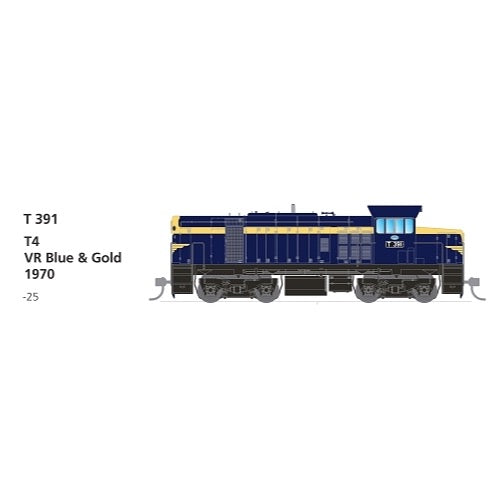
SDS Models HO T391 VR Blue & Gold T4 Series T Class Locomotive DCC Sound
The Victorian Railways received their second series of T class locomotives from late 1959, these were mechanically similar to the first series but featured a new raised height operating cab layout. This new style of raised cab design featured throughout the remainder of the T class series.
SDS Models are pleased to offer the inclusion of the T-2 series within our range of Victorian Railways T class models.
Based upon the tried and proven Austrains T class mechanism we have comprehensively retooled almost every item, bringing the model inline with our exacting scale and design standards. Some 220 new or re-made parts are involved in the production of the four series we are offering below. All the models now feature prototypically correct width long hoods, series specific and appropriate fuel tank and battery box combinations, improved appearance bogie side frames and brake shoe / wheel tread alignment and a host of other design detail enhancements.
Features
- Highly detailed Ready-to-Run HO gauge model
- Precisely tooled plastic body (ABS)
- Genuine Kadee scale head whisker coupler
- Separately applied handrails and detail parts
- 5-Pole skew wound electric motor and dual flywheels
- All wheel drive and electrical pickup
- LED head and marker lights
- All models come standard with an MTC 21 pin motherboard
- Exclusive and locally recorded EMD sounds by DCCSound
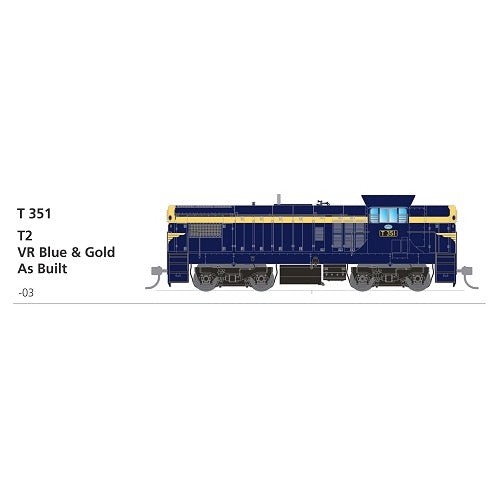
SDS Models HO T351 VR Blue & Gold T2 Series T Class Locomotive DCC Sound
The Victorian Railways received their second series of T class locomotives from late 1959, these were mechanically similar to the first series but featured a new raised height operating cab layout. This new style of raised cab design featured throughout the remainder of the T class series.
SDS Models are pleased to offer the inclusion of the T-2 series within our range of Victorian Railways T class models.
Based upon the tried and proven Austrains T class mechanism we have comprehensively retooled almost every item, bringing the model inline with our exacting scale and design standards. Some 220 new or re-made parts are involved in the production of the four series we are offering below. All the models now feature prototypically correct width long hoods, series specific and appropriate fuel tank and battery box combinations, improved appearance bogie side frames and brake shoe / wheel tread alignment and a host of other design detail enhancements.
Features
- Highly detailed Ready-to-Run HO gauge model
- Precisely tooled plastic body (ABS)
- Genuine Kadee scale head whisker coupler
- Separately applied handrails and detail parts
- 5-Pole skew wound electric motor and dual flywheels
- All wheel drive and electrical pickup
- LED head and marker lights
- All models come standard with an MTC 21 pin motherboard
- Exclusive and locally recorded EMD sounds by DCCSound
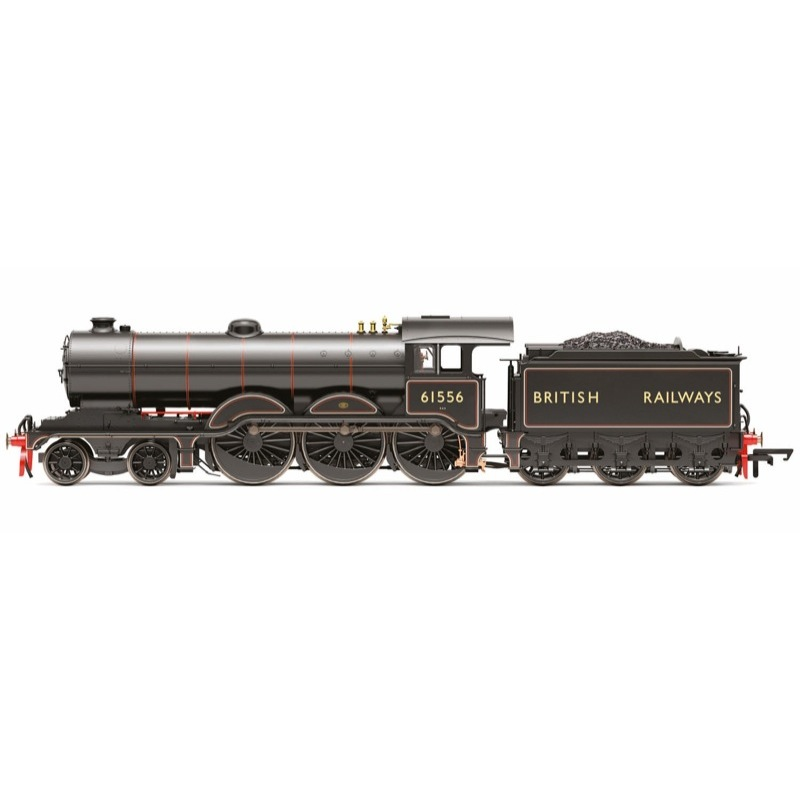
Hornby R3545 OO 4-6-0 Holden B12 Transition BR
The restrictions on locomotive weight and length were keenly felt by the Great Eastern Railway and whilst James Holden's S46, D56 and H88 Claud Hamilton 4-4-0 designs were not unduly restricted, when he came to consider a 4-6-0 design for high performance express work, the inside cylinder was his only real option. To gain power, Holden was quick to embrace the idea of superheating and so in 1911, the first order was placed for his S69 class locomotive.
Under the GER, seventy one S69 engines were built, fifty one at Stratford and twenty at Wm Beardmore & Co. in Glasgow. The large enclosed cab with side windows and an extended roof were a noticeable feature of Holden's design which, allied to the large Belpaire firebox, decorative valance over the driving wheels and short 3,700 gallon tender, gave the impression of the locomotive being bigger than it actually was. Allocated throughout East Anglian sheds, the S69 saw sterling service hauling the Liverpool Street-Norwich mainline trains, as well as the Harwich Boat Trains, Cambridge and Great Yarmouth services.
At Grouping in 1923, the S69 became classified as the LNER B12 and extended its range to Doncaster, Leeds and Manchester. The LNER plans for 2-6-4T engines to operate services to Southend were abandoned following issues with the type's stability and so a further ten B12 locomotives were ordered from Beyer, Peacock and Co to fill the void, the design being fitted with vacuum ejectors, Lenz poppet valves and dual air and vacuum brakes and classified as class B12/2. With large scale upgrading to the permanent way by the LNER, it at last became possible to increase the weight of locomotives and so a larger, round topped boiler pattern, with a bigger super heater was introduced, along with modified valve gear, resulting in a new B12/3 classification. Further modifications were carried out to the boilers of nine of the twenty five Scottish engines, this resulted in the final variation of the class, the B12/4.
During 1944, due to their wide route availability, a number of the B12/3s were utilized to work on ambulance trains hauling air braked, American built stock, mainly in the West Country. To improve the loading gauge, the footsteps were cut back and holes cut into them, making them instantly recognizable in later years. Seventy two locomotives entered British Rail service at Nationalization in 1948, further withdrawals taking place at regular intervals until the last locomotive, No.61572, was withdrawn in September 1961 and it is this engine that is preserved at the North Norfolk Railway. Locomotive 61576 was built at Beyer Peacock as a B12/2 and entered traffic at Gorton on August 31, 1928, remaining there until September 20, 1928 when it was transferred to Stratford. Spells at Colchester and Ipswich followed, the rebuild to B12/3 taking place in August 1932. During April 1944, whilst allocated to Colchester, the locomotive was adapted to work with the ambulance trains and it continued in service until January 1959, when it was withdrawn from Cambridge Shed.
Maximum curve Hornby 2nd radius + / 438mm+.
Specifications
- Colour: Black
- Coupling: NEM + Tension Lock
- DCC status: DCC Ready 8 pin socket
- Finish: Painted
- Gauge: OO
- Livery: Lined Black with Early Emblem
- Minimum radius curve: 2nd Radius (438mm)
- Motor: 5 pole skew wound
- Couplings: NEM
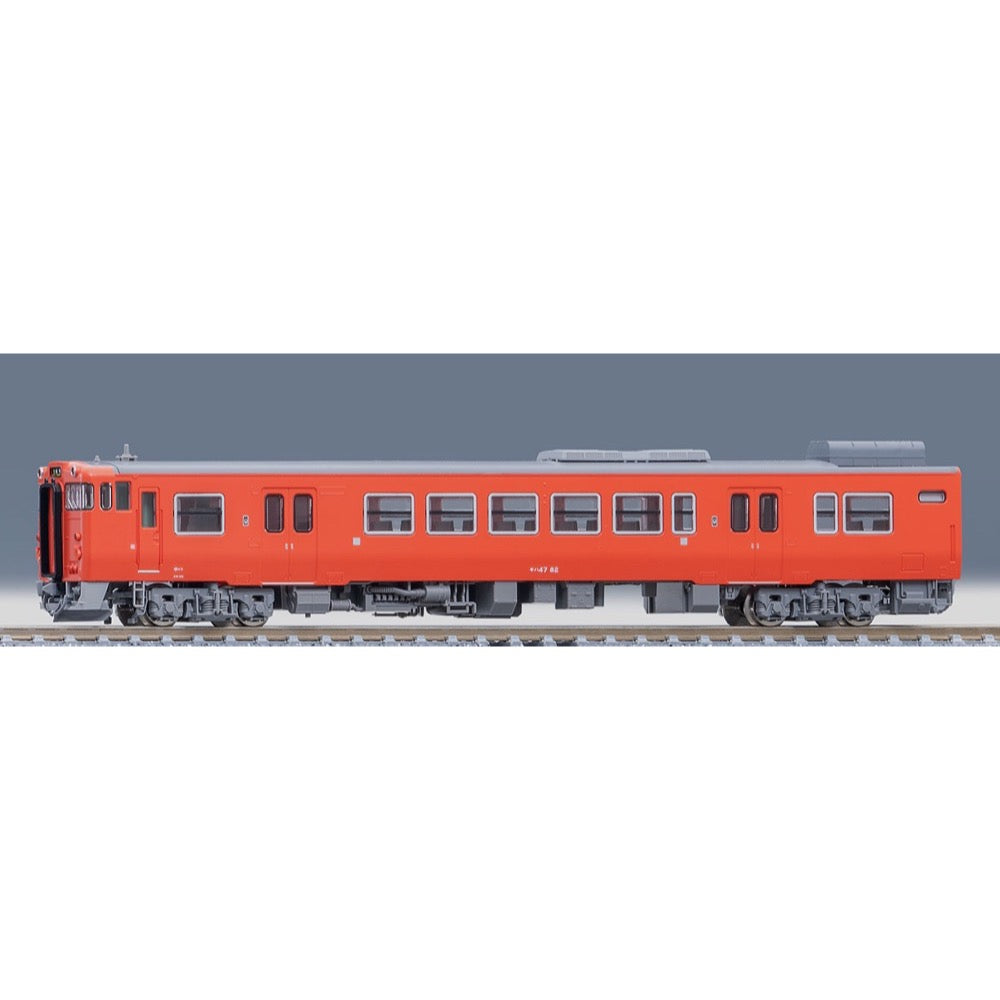
Tomix N KIHA 47-0 JR West Metropolitan/Goto Rolling Stock Yard T
The Kiha 47-0 and 1000 series were introduced as vehicles suitable for warm climates, mainly for the Western Japan region, and are equipped with two-stage lifting passenger windows.
Vehicles owned by JR West have undergone engine replacement and vehicle renewal work, and their appearance has changed significantly. Vehicles currently belonging to the Goto General Rolling Stock Depot Operation and Inspection Center and the Tottori Branch are in service on the San'in Main Line between Hamasaka and Nishiizumo, the Inbi Line between Chizu and Tottori, and the entire Sakai Line, and until March 2020, they were in service up to Wakasa Station on the Wakasa Railway.
Since 2016, line colors and route symbols have been introduced in the Yonago Branch (now the San'in Branch) area, and the design of the direction sign on the Kiha 40 series has been changed accordingly.
Features
- High Grade (HG) specifications
- Reproduces the JR West Kiha 47 type, which is deployed at the Goto General
- Rolling Stock Depot Operations Inspection Center and Tottori Branch and is mainly used on the San'in Main Line
- Reproduces the recent appearance with the addition of a jumper plug holder to the front
- Select from four types of typhoons, large and small, "shutter type" and "slit type"
- The front display part is replaceable and comes with a printed part "A Tottori"
- Replacement front display parts "B Tottori, B Chizu, C Yonago, C Sakaiminato" included
- Car number is selectable and compatible with transfer sheet (included in the set)
- Head and tail lights and front display part are equipped with a constant lighting board and ON-OFF switch
- Head and tail lights and front display part are lit by white LEDs
- The headlights light up in a color close to incandescent light by using a color prism
- The seats are reproduced in brown
- Shoe rubbing, door rails, and door buttons are printed
- Uses a new current collection system and silver wheels
- TN coupler (SP) is standard equipment
Accessories
- Runner parts: radio antenna, signal flare
- Runner parts: typhoon
- Runner parts: front display parts
- Runner parts: jumper plug (no hose)
- Parts: hood frame
- Parts: snowplow
- Parts: air tank
- Parts: jig
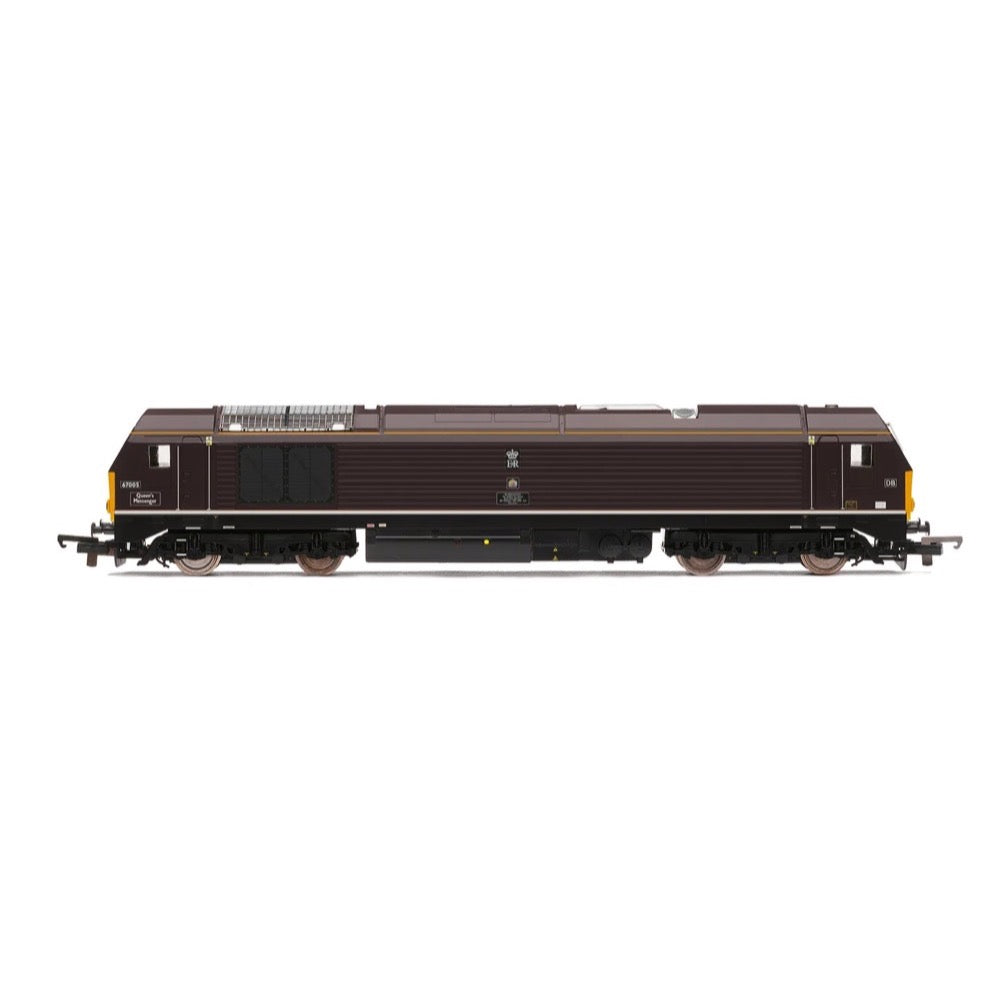
Hornby R30323 OO RailRoad Plus DB Class 67 Bo-Bo 67005 Queens Messenger Era 10 Locomotive
Class 67 locomotives are a class of Bo-Bo diesel-electric locomotives which were built for the English Welsh & Scottish Railway (EWS) between 1999 and 2000 by Alstom at Meinfesa in Valencia, Spain with drive components from General Motors' Electro-Motive Division, builders of the Class 66. The bodyshell is a monocoque load bearing Alstom design, the bogies are an "H" frame Alstom design, the engine, traction motors and control electronics are GM-EMD products.
Unlike the Class 66, the traction motors are frame mounted rather than axle hung to reduce unsprung mass and the gear ratio is increased allowing higher speeds which reflect the locomotives mixed traffic brief. The cab design has a central driving position. Initially the class were used primarily on mail trains. In June 2003 EWS lost the Royal Mail mail train contract, with services diminishing to complete cessation in March 2004. The locomotives have since been used by First ScotRail on the Caledonian Sleeper on non-electrified lines north of Edinburgh. In April 2015, GB Railfreight commenced a contract to haul the Caledonian Sleeper with 67004 repainted and renamed for use on the service.
When GB Railfreight started to provide the trains and crews for the Serco franchise in 2015, it was planned to use rebuilt Class 73/9s. The first of these came into service in February 2016. The Class 67s continued to be used on some services for another couple of years. Class 67s are also used as Thunderbird rescue locomotives for failed trains on the East Coast Main Line, on some freight trains and for use on chartered tourist trains. Two locomotives were assigned to, and received special liveries for, use with the Royal Train from 2003, and a third had a commemorative jubilee livery applied for use with the Royal Train during the Diamond Jubilee of Elizabeth II in 2012.
67005 is one locomotive assigned to the royal train, a service it has been responsible for since 2004. Initially in EWS maroon, the locomotive would later be named 'Queen's Messenger' 67005 is painted in the royal claret livery and operated by DB Schenker tasked with hauling members of the royal family around the UK.
This Railroad model fitted with a 3 pole motor and simple gearing, proving to be a reliable runner on any layout. The 8 pin DCC socket allows the model to be used on a digital layout where required and its railroad specification makes it ideal as a starter model.
Specification
- Item Length - Without Packaging (cm): 23
- Item Height - Without Packaging (cm): 5
- Item Width - Without Packaging (cm): 3.5
- Item Weight - Without Packaging: 0.23
- Item Scale: 1:76 Scale 00 Gauge
- Finish: Painted
- Colour:Claret
- Gauge: OO
- DCC Status: DCC Ready 8 pin socket
- Operator: DB Schenker
- Designer: Electromotive Diesel
- Wheel Configuration: Bo-Bo
- Livery: DB Royal Claret
- Minimum Curve (mm): Radius 2
- Motor: 3 Pole
- Number of Parts: 1
- Class: Class 67
- Buffer Type: Separate Plastic Buffers
- Coupling Type: Fixed Tension Lock
- Hornby Decoder Compatibility Primary: HM7000-8TXS: Bluetooth® & DCC Sound Decoder (8-pin)
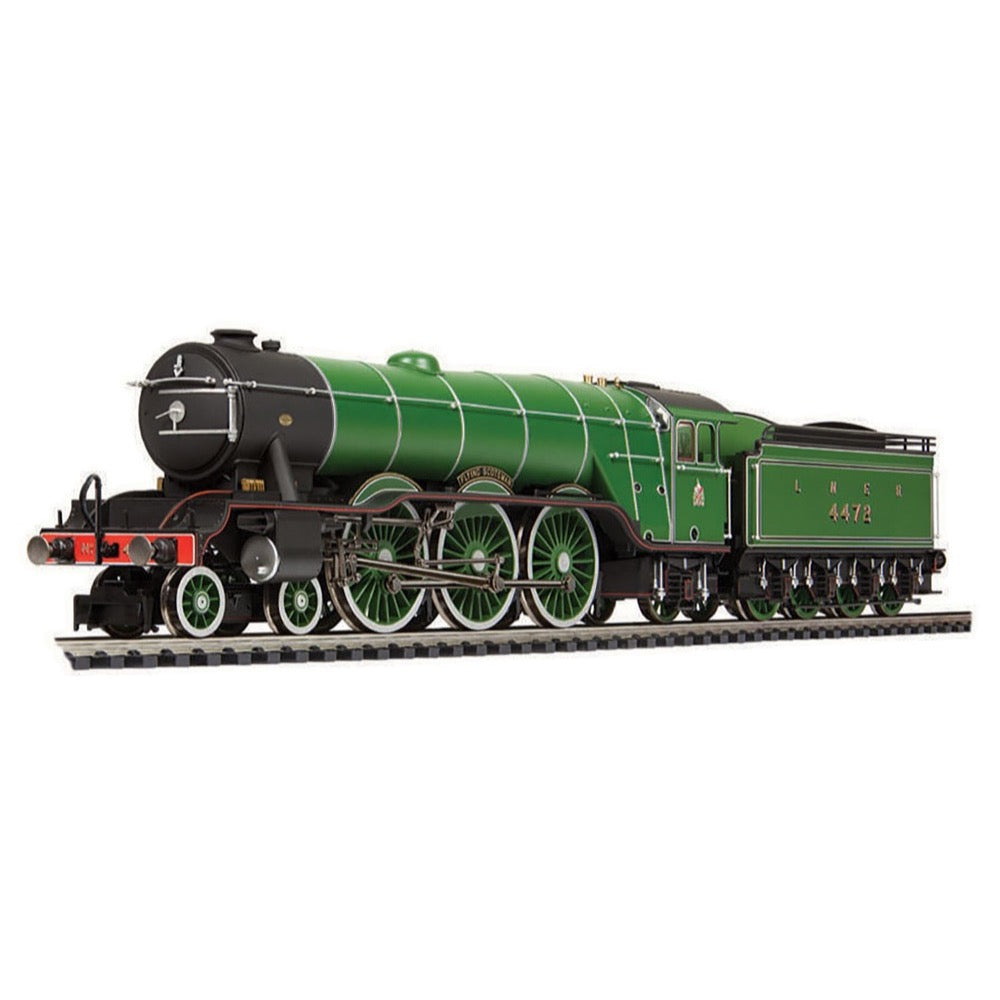
Hornby R30207 OO Hornby Dublo LNER A1 Class 4-6-2 4472 Flying Scotsman
This locomotive will be included in a bespoke box, along with a medallion featuring the Flying Scotsman centenary logo, operator, running number and year.
The largest of the constituent companies that would become the famous LNER was the GNR, and their Chief Mechanical Engineer naturally adopted the same position in the newly formed company, a man by the name of Herbert Nigel Gresley. As the brains behind the locomotive stock of the GNR, he had commissioned a new high speed passenger locomotive class to serve the GNR’s London to York main line. These became the A1 locomotive class, before a subsequent rebuild gave them the designation of the A3 class. One such example of this new and powerful class was named after the 10:00am service between London and Edinburgh, the named Special Scotch Express, or as it was renamed in 1924 the Flying Scotsman.
The locomotive in question, number 1472, was originally outshopped from the GNR’s Doncaster Works as a class A1 with GNR colouring, lettering and numbering before being renumbered and named in 1924 to promote the LNER’s Flying Scotsman service. Despite its new name and number, 4472 Flying Scotsman herself did not actually pull the Flying Scotsman service until 1928, spending the first four years of its life undertaking promotional work and light duties for the LNER, such as being its star exhibit at both the 1924 and 1925 British Empire Exhibition.
Relatively little of note would occur in the locomotives life and service for the next twenty years, with main changes consisting of her coupling with a corridor tender in 1928 (this allowed the locomotive to run non-stop between London and Edinburgh as the crew could be swapped via the tender mid run) before being reverted to the original tender in 1936. The game of LNER musical chairs did not stop here however, with the tender again being swapped in 1938 for a streamlined tender, with much the same appearance as a corridor tender without the corridor. Flying Scotsman would retain her streamlined tender until her withdrawal from British Railways service, numbered 60103, in 1963.
In preservation, Flying Scotsman has captured the hearts of the nation, becoming recognised by even those with less than a passing interest in railways and railway history. Under various notable owners, including Alan Pegler and Sir William McAlpine, Flying Scotsman has undertaken tours of America and Australia with mixed success and under ownership of the National Railway Museum saw a six million pound overhaul, cementing her future as a main line stalwart. Alan Pegler, the original saviour of the locomotive passed away in 2012, with his ashes being thrown into Scotsman’s firebox on the Farewell Alan Pegler rail tour between King’s Cross and York in 2018.
This Hornby Dublo model features the locomotive as it would have appeared in 1924 at the British Empire Exhibition. The locomotive is finished in a gleaming green paint which couples with the diecast boiler to create a finish close to that that could have been seen on the full size locomotive. The model features a strong 5 pole motor, cab detailing including crew figures, a diecast body and is DCC ready.
Specifications
- Item Length - Without Packaging (cm): 29.1
- Item Height - Without Packaging (cm): 5
- Item Width - Without Packaging (cm): 3.5
- Item Weight - Without Packaging: 0.6
- Item Scale: 1:76 Scale 00 Gauge
- License: Yes
- License line: Produced under licence for SCMG Enterprises Ltd. © SCMGE. Every purchase supports the museum.
- Finish: Painted
- Colour: Green
- DCC Status: DCC Ready 8 pin socket
- Operator: LNER
- Designer: Sir Nigel Gresley
- Wheel Configuration: 4-6-2
- Livery: LNER Apple Green
- Minimum Curve (mm): Radius 2
- Motor: 5 Pole Skew wound
- Number of Parts: 1
- Class: Class A1
- Buffer Type: Sprung Metal Buffers
- Coupling Type: NEM Tension Lock
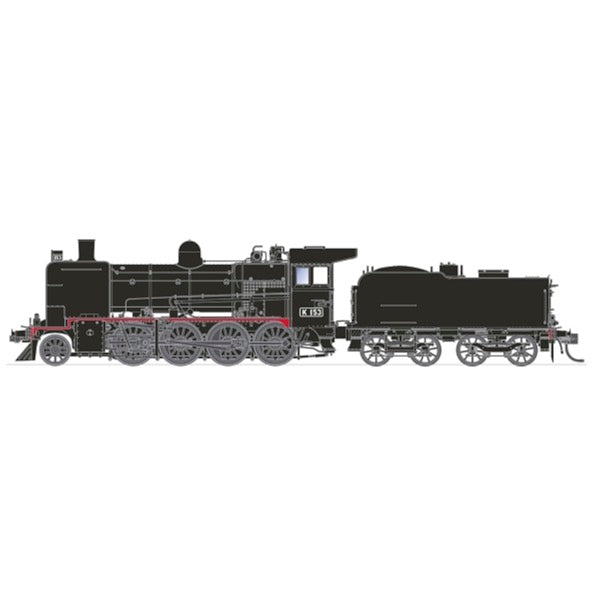
Phoenix Reproductions HO K153 Preserved 1970s K Class Locomotive DCC Sound
The Victorian Railways built 53 K class engines at Newport Workshops over a 24 year period, commencing in 1922. The first series of 10 engines were progressively rebuilt in the 1940s to match the performance and visual appearance of the other class members. Later in 1946 the last 9 engines entered service, these engines had single cab side windows and the last 7 engines were fitted Boxpok style driving wheels.
They were extremely versatile engines and could be found and all classes of trains, many worked until the late 1960s and several into the early 1970s.
The Phoenix Reproductions model represents the class in it's later years of government service as well as several colourful liveries of early days preservation.
Features
- Highly detailed Ready-to-Run HO gauge model
- Diecast boiler, frame and footplate
- Genuine Kadee scale head whisker coupler (Tender)
- Separately applied boiler details
- Working LED lights
- All models come standard with an MTC 21 pin motherboard
- Keep Alive Circuit
- DCC version with LokSound V5 decoder
- 22" Minimum Radius
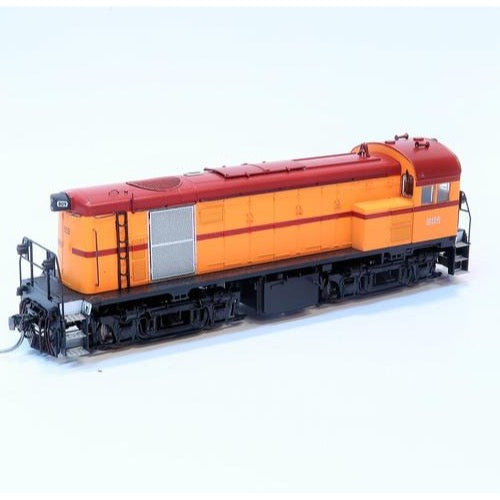
SDS Models HO 809 SAR Traffic Yellow 800 Class Locomotive
SDS Models HO 809 SAR Traffic Yellow 800 Class Locomotive
Entering service from the mid 1956 onwards these 10 English Electric 750 HP shunting locomotives were numbered from 800 to 809. They were predominantly found working around Port Adelaide and in particular Gilman Yard. Later and from time to time they could also be found working Passenger trains around the suburbs. They remained in service until the late 80s and some units through until 1991, all except 801 were scrapped. When AN commenced operations the class leader 800 was renumbered to 810.
Features
- Highly detailed Ready-to-Run HO gauge model
- Precisely tooled plastic body (ABS)
- Genuine Kadee scale head whisker coupler
- Separately applied handrails and detail parts
- 5-Pole skew wound electric motor and dual flywheels
- All wheel drive and electrical pickup
- LED head and marker lights, body mounted
- All models come standard with an MTC 21 pin motherboard



